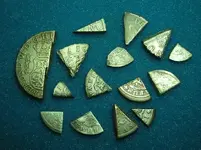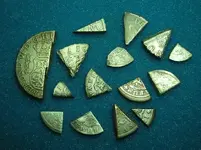Steve in PA
Gold Member
- Joined
- Jul 5, 2010
- Messages
- 9,606
- Reaction score
- 14,239
- Golden Thread
- 4
- Location
- Pittsburgh, PA
- 🥇 Banner finds
- 4
- Detector(s) used
- Fisher F75, XP Deus, Equinox 600, Fisher 1270
- Primary Interest:
- All Treasure Hunting
I have been lucky enough to have dug 15 of these quaint little pieces. Thirteen were found in Southwestern PA and two in Virginia. I consider them half coin, half relic. Between digging them myself, observing others that are posted on the various forums, and communicating with other colonial relic hunters, I have drawn a few conclusions about these pieces. Here are my thoughts. Feel free to chime in or post your cut pieces.
1. More cut Spanish Silver is found in Virginia (especially the Tidewater area) than anywhere else.
2. Cut Spanish Silver rarely turns up in eastern Pennsylvania, New Jersey, and New England even though plenty of complete Spanish Silver coins are found.
3. Cut Spanish silver is found in Southwestern Pennsylvania probably because the area was claimed by Virginia in colonial times.
4. The most commonly cut Spanish coin was the 2 reale Pistereen.
5. "Portrait" stlye Spanish coins are rarely found cut, even though the majority of complete coins found are portrait. This may mean the practice of cutting Spanish silver was phasing out by 1772 when the portrait style coinage was introduced.
6. Some coins (even the thick 8 reales) were cut very professionally, perhaps by silversmiths, while others appear to be very crude "field cut" pieces. This is obvious when looking at my examples.
Here are my pieces. Hopefully I can add a couple more in 2012.
1. More cut Spanish Silver is found in Virginia (especially the Tidewater area) than anywhere else.
2. Cut Spanish Silver rarely turns up in eastern Pennsylvania, New Jersey, and New England even though plenty of complete Spanish Silver coins are found.
3. Cut Spanish silver is found in Southwestern Pennsylvania probably because the area was claimed by Virginia in colonial times.
4. The most commonly cut Spanish coin was the 2 reale Pistereen.
5. "Portrait" stlye Spanish coins are rarely found cut, even though the majority of complete coins found are portrait. This may mean the practice of cutting Spanish silver was phasing out by 1772 when the portrait style coinage was introduced.
6. Some coins (even the thick 8 reales) were cut very professionally, perhaps by silversmiths, while others appear to be very crude "field cut" pieces. This is obvious when looking at my examples.
Here are my pieces. Hopefully I can add a couple more in 2012.
Attachments
Upvote
1






